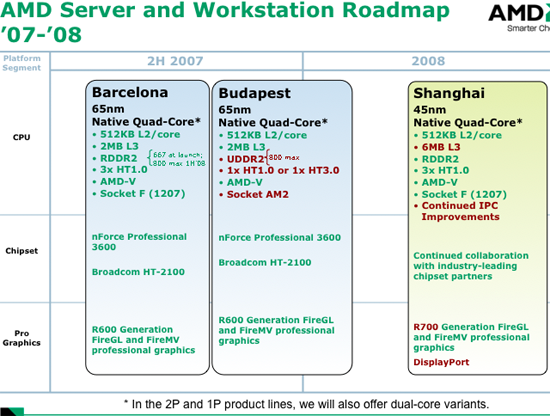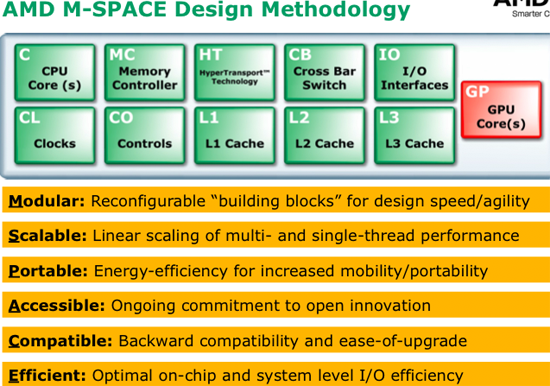Shanghai: What Immediately Follows Barcelona
In the second half of 2008, AMD will introduce its first 45nm processor under the codename Shanghai.
Shanghai will be an evolutionary step above Barcelona, adding a larger L3 cache and some IPC enhancements at both the core and North Bridge levels. Shanghai will keep the same 512KB L2 cache per core of Barcelona, but grow the shared L3 cache from 2MB to a full 6MB. Note that this is still less cache than Penryn will offer in its quad-core configurations, but with AMD's integrated memory controller, larger caches aren't as necessary.
Shanghai, like Barcelona, is targeted at the server market. There will be a desktop variant also introduced in the second half of 2008 with similar specs. Shanghai and its desktop equivalent will be socket-compatible with Barcelona/Phenom motherboards.
AMD has also indicated that Shanghai will begin AMD's transition to DDR3 on the desktop, indicating that the desktop version may be available in two different sockets: AM2 for DDR2 support, and AM3 for DDR3 support. In the first half of 2009, Sandtiger will follow Shanghai in the server space with a brand new architecture (we'll talk about this core shortly). Sandtiger will be exclusively DDR3 and will definitely require a new platform, and just like Shanghai there will be a desktop variant of Sandtiger as well.
Intel : tick-tock :: AMD : Pipe?
One thing we've been waiting to hear from AMD is how it would compete with Intel's tick-tock cadence of microprocessor releases. To recap, Intel's new model shows that every two years it will introduce a new microprocessor architecture, and on the alternate year in between it will introduce a new manufacturing process on the existing architecture.
Today, AMD confirmed that it, too, would be releasing a new microprocessor architecture every two years, and a new manufacturing process on the alternate years. AMD attempted to go one step further and tie platform technology to the cadence as well; confirming that every two years the platform would change, alongside the microprocessor architecture, to support new features as they are available. It's a minor distinction but the main point is that AMD is committed to Intel's 2-year processor cycle.
Oh, and the acronym is horrible guys.
mmmm-space
In our AMD: The Road Ahead article we looked at AMD's modular approach to CPU design going forward:AMD has now attached a marketing name to its modular core approach: M-Space:

The principle is still the same; these discrete blocks within a microprocessor can be things like GPU cores, CPU cores, memory controllers, specialized hardware, etc... There's nothing really new here, we just wanted to make sure you were up to date with the latest and greatest in AMD marketing so you don't get confused.
The next part however, we can't guarantee that it won't confuse you.










31 Comments
View All Comments
Lord Evermore - Sunday, July 29, 2007 - link
What the heck are RDDR and UDDR? My only guess is the U might stand for the UMA design, but I don't know if that would be preferred for the server or workstation.Anand Lal Shimpi - Tuesday, July 31, 2007 - link
RDDR = Registered DDRUDDR = Unbuffered DDR
Take care,
Anand
Martimus - Thursday, August 2, 2007 - link
Ok, what is OoO? I couldn't find it with a search on Google.Spartan Niner - Saturday, August 4, 2007 - link
OoO is "out-of-order" referring to OoOE, "out-of-order-execution"http://en.wikipedia.org/wiki/Out_of_order_executio...">http://en.wikipedia.org/wiki/Out_of_order_executio...
Martimus - Monday, August 6, 2007 - link
Thanks.xpose - Saturday, July 28, 2007 - link
This is the best future roadmap article I have ever read. I am actually excited. No really.najames - Friday, July 27, 2007 - link
I am an AMD fanboy, of 7 computers I have at home, only the 5 year old laptop has an Intel chip now. Dual cores are actually likely all I REALLY need. That said, I am sick of a bunch of hype and no new products. It's all blow and no show. I don't care about years down the road because it could all change between now and then.AMD/ATI could be a good thing too if they make good, polished drivers, 100% working for what was promised. How about throwing people a bone to make them switch, maybe even make some kick butt Linux drivers too.
We were all on an AMD bus and nobody has been driving since the X2 chip. They taunted Intel and handed out huge bonuses, but forgot about any new development. I have to credit Intel, they kicked butt with Core 2, and seem to be doing more butt kicking going forward.
I watched Hector on CNBC last night and he didn't look like he had a clue what was going on. Granted they weren't asking him details of any processors, but he was dodging basic business questions. Why do I have several hundred shares of AMD?
Regs - Monday, July 30, 2007 - link
Because those relatively cheap shares, compared to Intel's, might be worth hundreds of times more one day from that stuff you call blow. Blow = prospects in business terms.
I would say the same thing as you did though at first. It's obvious AMD and ATi's pipeline dried up and unfortunately both consecutively. You can argue that the 2900XT is a good card, performs well, etc..etc.. but that doesn't explain why AMD offers crapware for main stream (where the real money is). As for AMD's CPU line up...well..you can only sell old for so long in the technology sector without taking a hit.
kilkennycat - Friday, July 27, 2007 - link
.... dump ATi. The marriage made in hell. New products unable to meet schedule and with inferior performance, thus no way of rapidly recovering development costs by pricing for performance.Dave Orton sure did a neat sell-job on AMD, walking away with $$millions when AMD paid a 20% premium for a chronically non-performing company barely managing to eke out some tiny profits during the last couple of years. No wonder Mr. Orton was finally shown the door.
kleinwl - Friday, July 27, 2007 - link
What is the problem with AMD, did they not receive enough feedback that UVD is a "must have" on high end units. I don't want to have choose between good gaming performance and movie performance... I am paying a ridiculous premium already for hardware... the least they could do is make sure it has all the bells and whistles.